The Oaxacan-born cook caring for Yamaguchi Nursery’s historic bonsai collection
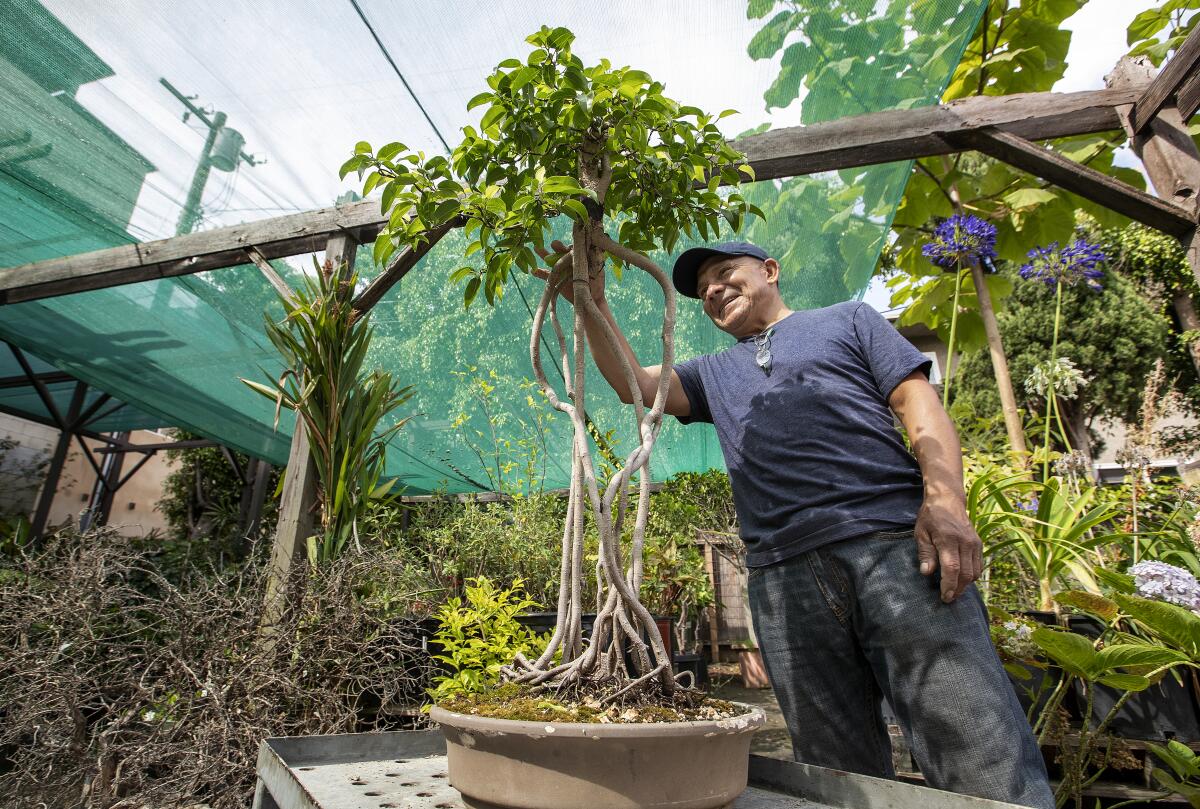
- Share via
For a few hours every afternoon, when the roar of the 405 Freeway becomes a murmur, Miguel Hernandez can hear the results of his work from the small shed at the edge of Yamaguchi Nursery on Sawtelle Boulevard.
A smile blooms on his face as a chorus of reverent whispers reaches his ears. “Wow!” “This is amazing.” “Look at this!”
The bonsai collection at Yamaguchi Nursery has some of the oldest and most valuable trees in Southern California, which is considered by some bonsai artists to be the art form’s mecca in America. Ever since founder George Yamaguchi died in 2005, Hernandez has cared for Yamaguchi’s creations as the nursery’s resident bonsai artist.
Bonsai wasn’t always accessible to people like Hernandez, who came to the U.S. from Oaxaca when he was 15. In Japan, a frenzied market for luxury horticulture produces big egos, obscene prices and a cloistered scene with formalized styles and methods.

But in the U.S., bonsai has always been the project of devoted hobbyists, and most of them are not Japanese. John Naka, known to enthusiasts as the godfather of American bonsai, eschewed competition and encouraged a focus on personal mastery. Along with Yamaguchi and other Japanese Americans such as Ben Oki and Harry Hirao, he traveled the country and taught anyone willing to put in the time and do the work.
John Yoshio Naka, the world-renowned bonsai master who was credited with bringing the art to Western culture, has died.
Although he refuses the term master and is reluctant to call himself an expert, Hernandez is the type of bonsai artist that only a place such as Los Angeles could produce. Four days a week, he works full time as a cook at Factor’s Famous Deli on Pico Bouelvard, where he is the most senior employee. He also is an avid marathon runner and has competed in 26 races around the world, including the Boston Marathon.
At home, he cares for more than 600 of his own bonsai, and he is always making more.
“You build them up, and you watch it grow, and I don’t know,” Hernandez said. “It’s just amazing. You make this frame, and then Mother Nature fills it up. And some of them bloom, and they give you pleasure.”
::
Hernandez, 58, grew up helping his father grow corn, onions and tomatoes on their family farm in a small village in Oaxaca. Pleasure wasn’t part of what he learned. As a boy, he remembers his parents scolding him for planting a papaya tree in a pot because it would never bear fruit.
“But I didn’t want to eat it. I just liked the way it looked, there in the pot,” Hernandez said.
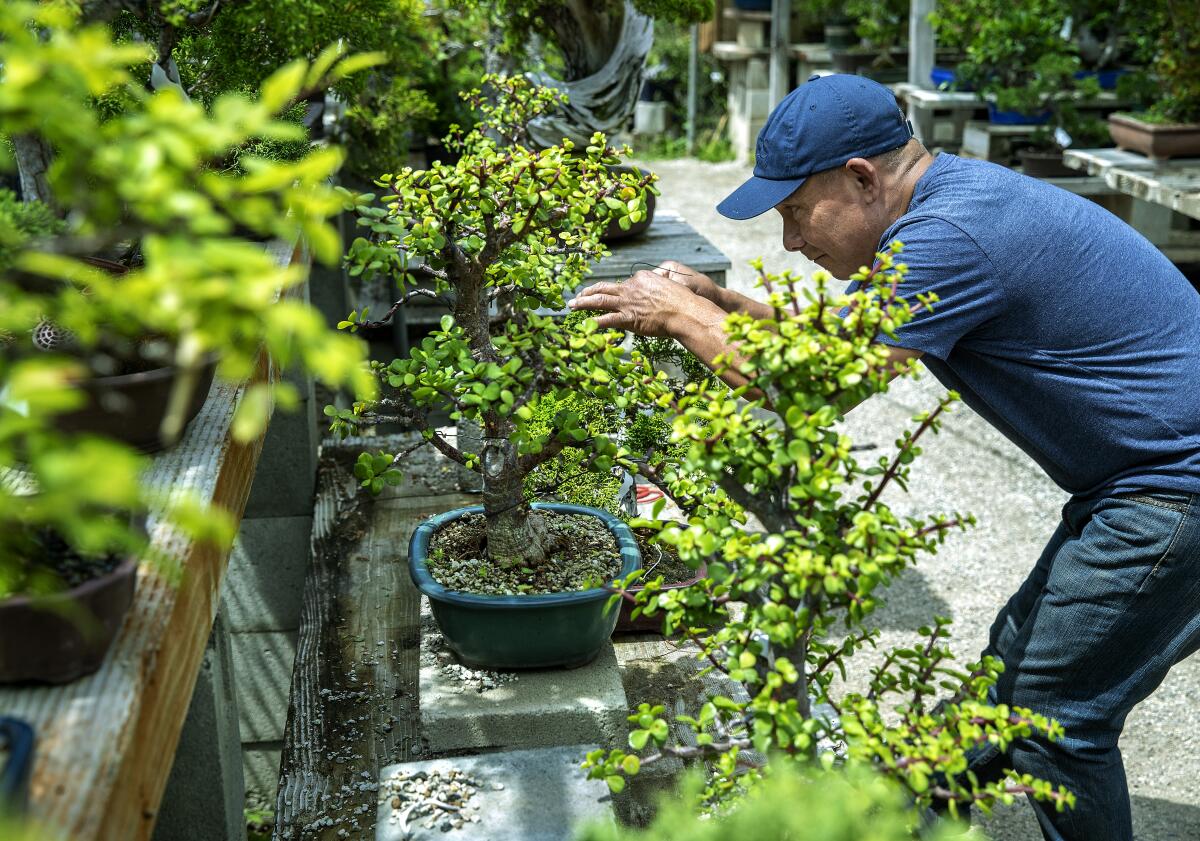
In 1980, he came to the U.S. to find work and landed at Junior’s Delicatessen in Westwood. He used to walk by the nursery on his way home from work. He was so fascinated by the tiny trees that he began to spend hours peering over the fence and watching Yamaguchi work.
Yamaguchi was famously a man of few words. Robert Pressler, current president of the California Bonsai Society, says it took five years of visiting the nursery almost every week until the elder bonsai artist would address him with anything more than a grunt.
Yamaguchi taught a conservative and classical style, now considered old school, that emphasized the movement of a wild tree’s growth in nature. He specialized in black pines and yose ue, the forest style of bonsai that places several trees together in one pot.
Modern styles employ power tools and dramatic contortions, but Yamaguchi had a gentle touch. He believed each tree had a certain form that would unlock its potential, and the artist’s job was to manage that growth.
His most famous tree, collected in the National Bonsai Museum in D.C., is called Shinsei, meaning “voice of the gods.” The tree is a powerfully built, asymmetrical black pine whose branches flare boldly at the bottom, recalling how a tree might look if it stood alone in a meadow without competing with other trees for sunlight. The museum’s description calls the tree an example of the diversity of North American bonsai, which does not establish right or wrong ways to do bonsai.
His nursery, established in 1949, did much of its business supplying raw plant materials for landscaping businesses and home gardens. But Yamaguchi spent most of his time in the back with the bonsai. He seemed to prefer trees to humans. He would get mad at people if they let their bonsai die, said his daughter Marianne Yamaguchi.
Yamaguchi never named or trained a successor, Marianne said. But after Hernandez spent a few months of silent observation at a distance, Yamaguchi told the younger man to come to the nursery and start taking classes.
As Hernandez recalls it, Yamaguchi told him, “You’re not going to learn anything else by watching.”
Hernandez learned mostly by watching Yamaguchi and paying attention to how the bonsai artist would correct his trees. Hernandez’s first tree, purchased at a sale, was a juniper tree that died after a few months because he kept it indoors instead of outside where it belonged.
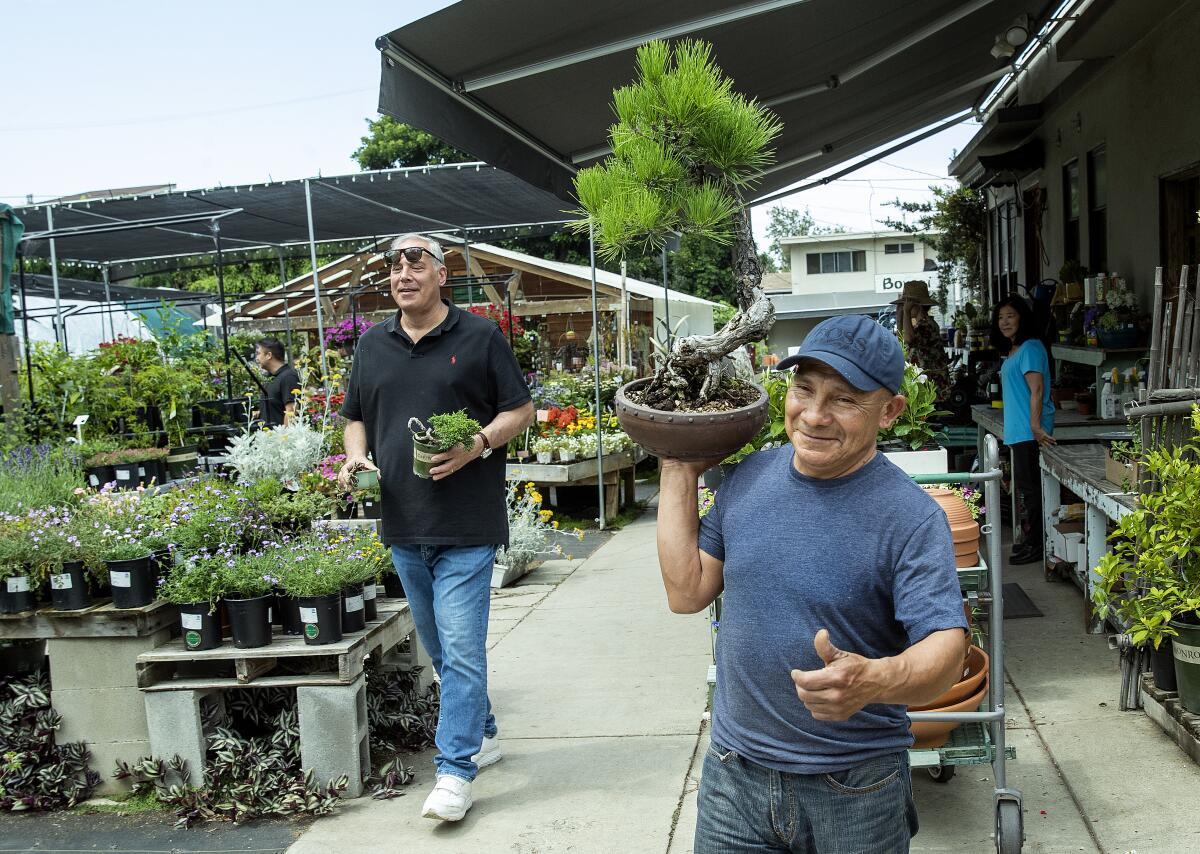
Yamaguchi taught him to fertilize the roots, wire the branches and read a tree’s movement and natural form. Hernandez’s work in the kitchen gave him quick, steady hands, and soon he realized that taking care of bonsai was as simple as following a recipe.
“It’s like a checklist, like in the morning you get up, you eat breakfast, you go running, you brush your teeth.”
Once he learned the trick of keeping trees alive, it was addicting. Soon he was driving hours into the desert to forage for naturally occurring bonsai trees. When his boss at the restaurant bought a property with an olive tree on it, Hernandez rescued the tree from the chainsaw and took about 100 clippings he is currently turning into bonsai.
George Yamaguchi is an artist who molds trees into elegant statues.
His favorite kinds of trees have quirky, improvisational shapes and forms, like a ficus tree, severed at the trunk and supported by the exposed roots, like an octopus standing up on its tentacles.
At the nursery, under the green shade that protects the bonsai from the sun, Hernandez is quiet, but his hands are restless, pinching off buds and branches, poking to check the moisture of soil, inspecting the texture of bark and branch.
Some of his touches seem less functional and more like affectionate caresses for beloved pets, and a fond smile plays around his lips.
::
Yamaguchi Nursery on Sawtelle, and its neighbor Hashimoto Nursery, are among the few surviving connections to the area’s agricultural history. In the 1900s, much of the area was farmland worked by Japanese Americans.
The neighborhood, which is the western-most Asian enclave in Los Angeles, was exempted from redlining in part because Westside homeowners treasured Japanese landscaping and wanted their gardeners to live nearby, according to “Sawtelle: West Los Angeles’s Japantown.” A large, endemic population of homeless veterans also made the land less desirable to white homeowners.
Now Yamaguchi Nursery is one of the largest properties on a street where buildings regularly change hands for tens of millions of dollars. The nurseries offer a peaceful green respite on a street that’s jammed most nights with locals drawn to the vibrant restaurant scene and nightlife.
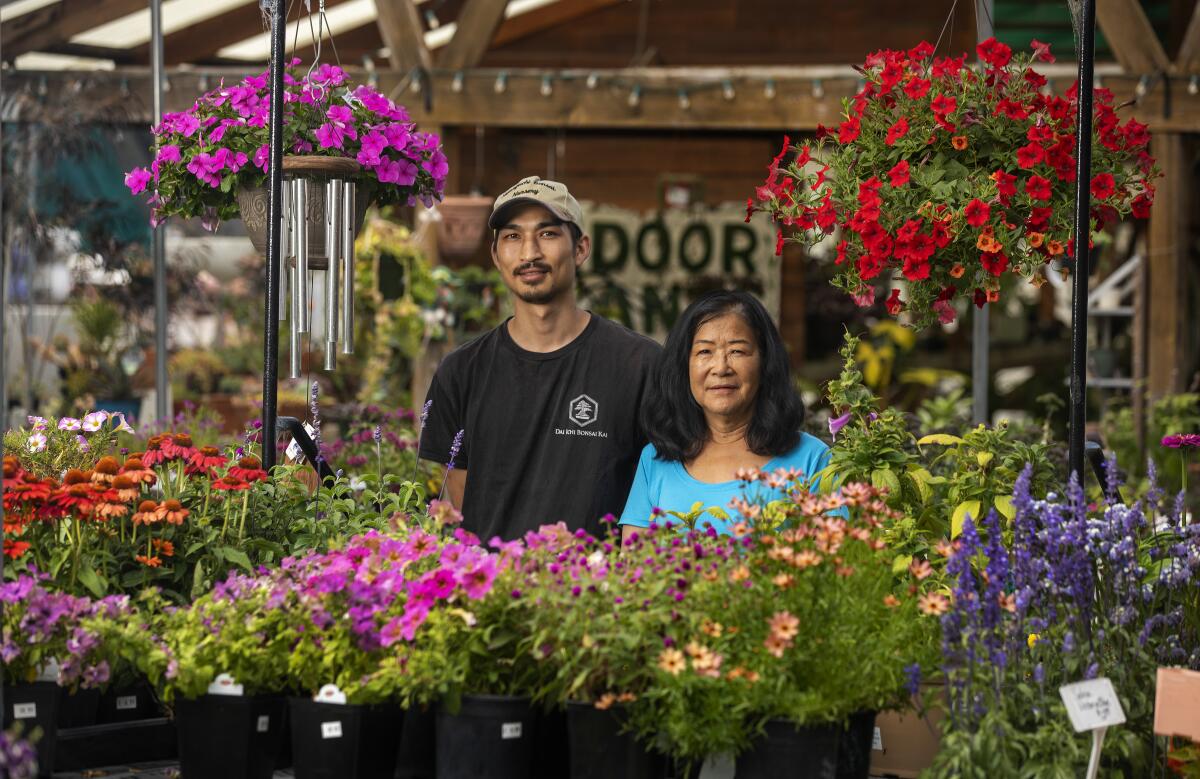
Marianne left her job in environmental management before helping to run the nursery. She’s not sure what the fate of the nursery will be, though she would like to keep it going. Her nephew, Kyle Lew, 30, is a talented bonsai artist who has worked on some of his grandfather’s trees. He also wants the nursery to remain open, but he isn’t sure of his plans yet either.
Interest in bonsai grew during the pandemic’s lockdown conditions, and overall, the industry is headed toward more competition and larger price tags. The most popular artists go to Japan to train, then offer courses online and in person at teaching nurseries. In Japan, the most expensive bonsai can sell for more than a million dollars, and even at private auctions in the U.S., prices are inching toward six figures.
Meanwhile, Hernandez comes in two days a week to keep the bonsai alive. He works at the same table where Yamaguchi once sat.
There’s a simplicity in his work that other artists say echoes that of Yamaguchi. Hernandez also aspires to mastery, but being around the trees is its own kind of joy for a man accustomed to the methodical pleasures of marathons.
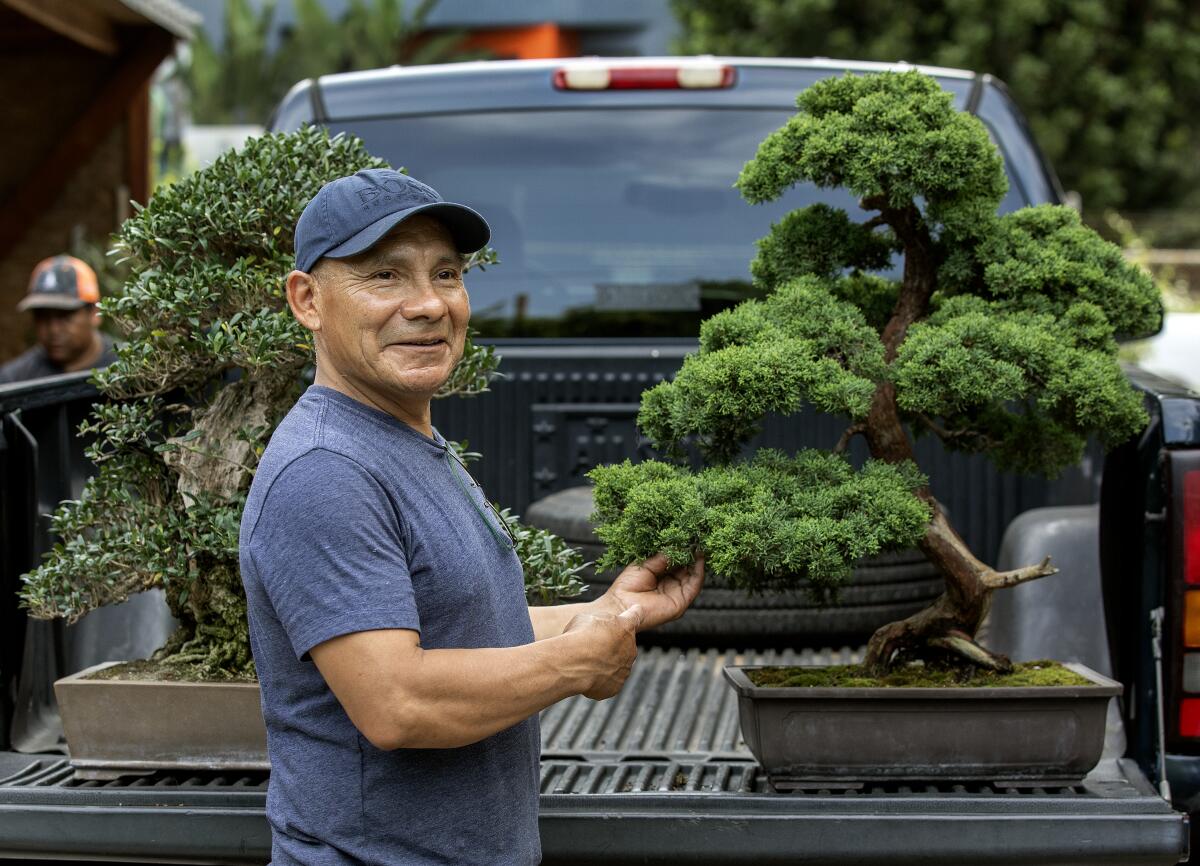
More than anything, Hernandez sees himself as the caretaker of hundreds of tiny miracles. Each tree is like a parable of how life can be coaxed from the hardest conditions and what beauty can be found in that struggle.
“I don’t know why people say bonsai are always dying,” Hernandez said. “I always see them green. All green everywhere all the time.”
More to Read
Sign up for Essential California
The most important California stories and recommendations in your inbox every morning.
You may occasionally receive promotional content from the Los Angeles Times.











